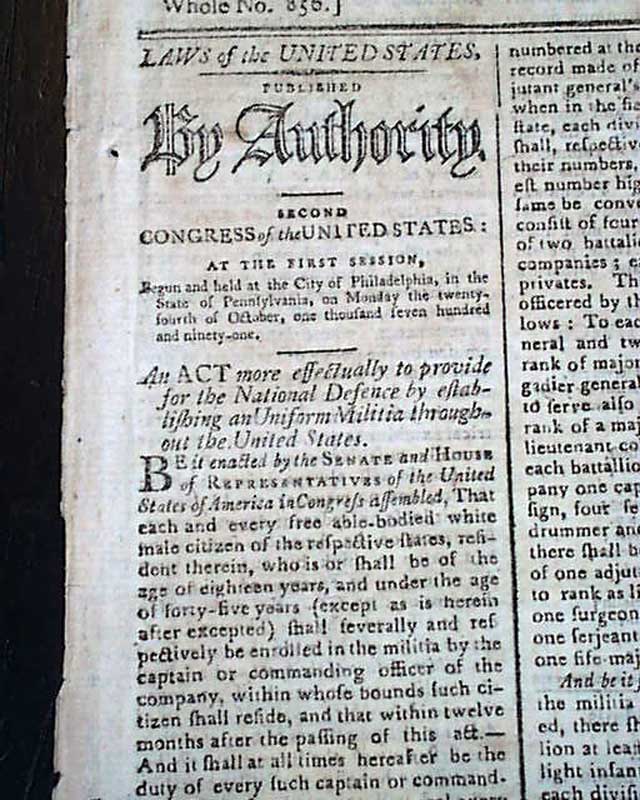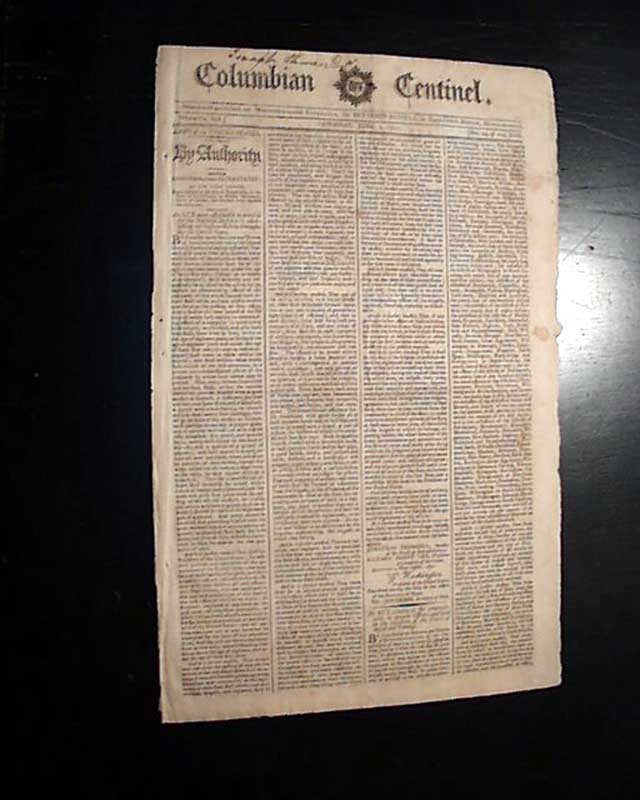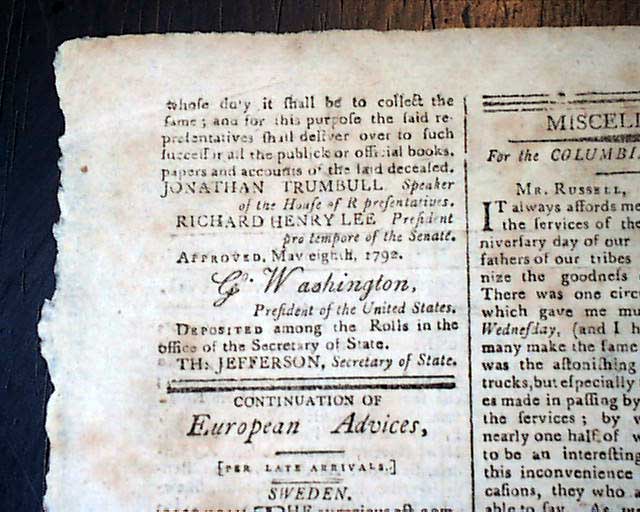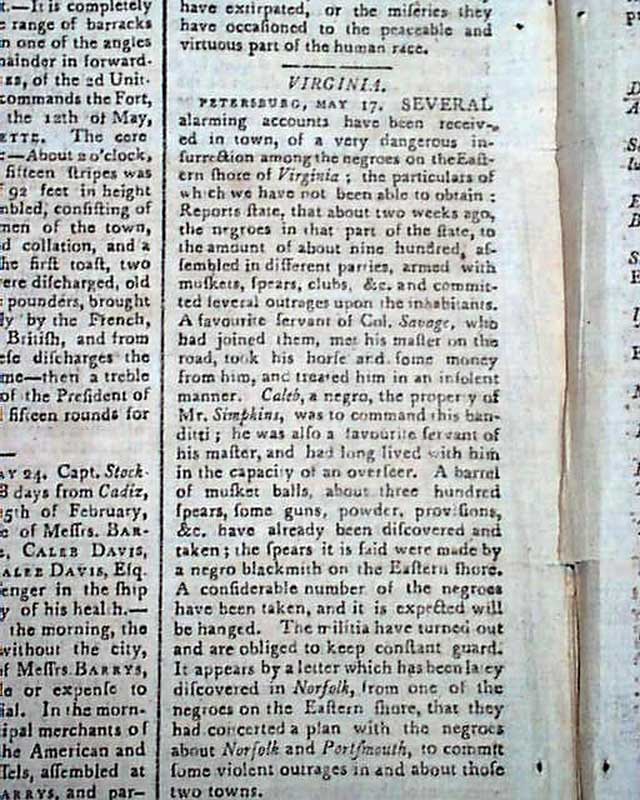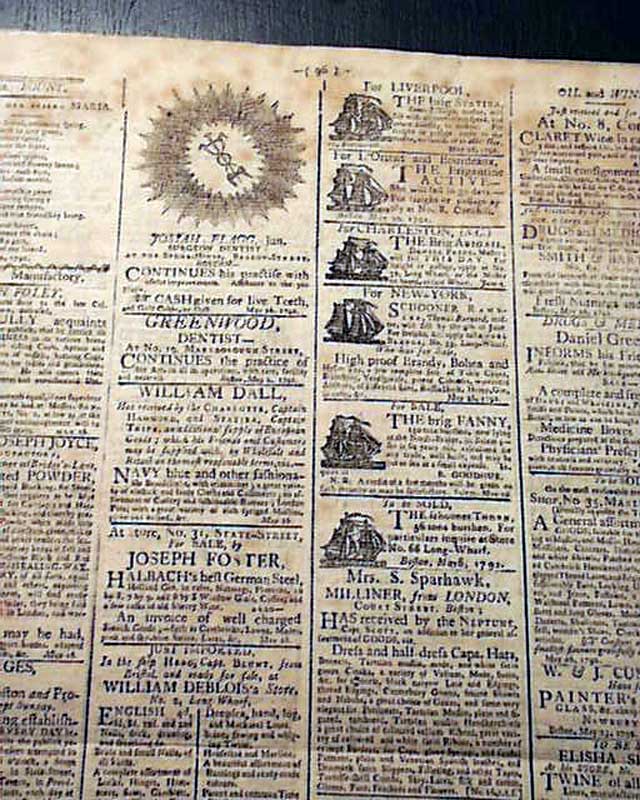Home >
Building & dedicating Fort Fayette in Pennsylvania... The Second Militia Act...
Building & dedicating Fort Fayette in Pennsylvania... The Second Militia Act...
Item # 703606
June 02, 1792
COLUMBIAN CENTINEL, Boston, June 2, 1792
* 2nd - Second Militia Act of 1792
* President George Washington signs
* Fort Lafayette - Pittsburgh, Pennsylvania
* Major General Anthony Wayne
Most of the front page is taken up with a Act of Congress now known as the Second Militia Act, signed in script type by the President, Go. Washington on May 8, 1792.
It is officially entitled: "An ACT More Effectually to Provide for the National Defense by Establishing a Uniform Militia Throughout the United States".
As noted in Wikipedia, the second Militia Act of 1792 was passed on May 8, 1792, and provided for the organization of state militias and the conscription of every "...free able-bodied white male citizen..." between the ages of 18 and 45. It notes in part:
"... each and every free able-bodied white male citizen of the respective States, resident therein, who is or shall be of age of eighteen years, and under the age of forty-five years (except as is herein after excepted) shall severally and respectively be enrolled in the militia, by the Captain or Commanding Officer of the company, within whose bounds such citizen shall reside...".
Militia members were required to equip themselves with a musket, bayonet and belt, two spare flints, a box able to contain not less than 24 suitable cartridges, and a knapsack.
Another Act of Congress begins on page 1 & concludes on page 2 where signed in script type: Go. Washington.
Page 2 has a nice report on the dedication of the new Fort Fayette [Lafayette], which was built in this year by General Anthony Wayne.
Page 2 also has a detailed account of a slave insurrection near Petersburg, Virginia.
background: The Second Militia Act of 1792, enacted by the U.S. Congress on May 8 of that year, mandated that all free, able-bodied white male citizens between the ages of 18 and 45 be enrolled in their state’s militia and equip themselves with specified arms and supplies, such as a musket, bayonet, ammunition, and knapsack. Designed to create a uniform and reliable national defense system without relying on a large standing army, the act placed responsibility on individual citizens for their own military preparedness and on state governments for organizing and disciplining the militias according to federal standards. While the law aimed to strengthen the nation's security in response to internal unrest and external threats, it suffered from inconsistent enforcement and inequities—particularly its exclusion of non-white citizens and its assumption that all enrollees could afford their own equipment. Ultimately, the Second Militia Act laid foundational groundwork for the U.S. militia system, influencing military policy for over a century until the formal establishment of the National Guard in the early 20th century.
Another Act of Congress begins on page 1 & concludes on page 2 where signed in script type: Go. Washington.
Page 2 has a nice report on the dedication of the new Fort Fayette [Lafayette], which was built in this year by General Anthony Wayne.
Page 2 also has a detailed account of a slave insurrection near Petersburg, Virginia.
background: The Second Militia Act of 1792, enacted by the U.S. Congress on May 8 of that year, mandated that all free, able-bodied white male citizens between the ages of 18 and 45 be enrolled in their state’s militia and equip themselves with specified arms and supplies, such as a musket, bayonet, ammunition, and knapsack. Designed to create a uniform and reliable national defense system without relying on a large standing army, the act placed responsibility on individual citizens for their own military preparedness and on state governments for organizing and disciplining the militias according to federal standards. While the law aimed to strengthen the nation's security in response to internal unrest and external threats, it suffered from inconsistent enforcement and inequities—particularly its exclusion of non-white citizens and its assumption that all enrollees could afford their own equipment. Ultimately, the Second Militia Act laid foundational groundwork for the U.S. militia system, influencing military policy for over a century until the formal establishment of the National Guard in the early 20th century.
Category: The 1600's and 1700's


